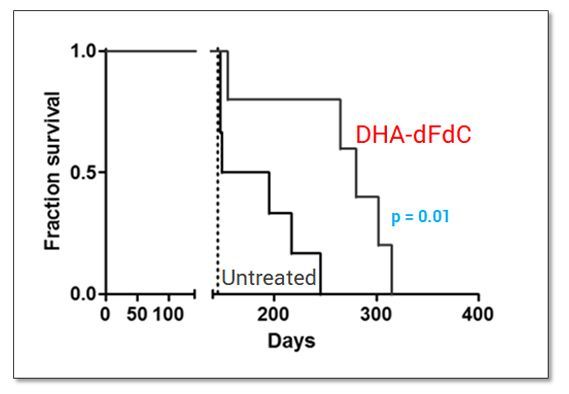Pancreatic Cancer.
DHA-dFdC
Licensed From the University of Texas at Austin for the treatment of Pancreatic Cancer.
Background
Pancreatic cancer is the 3rd leading cause of cancer-related death in the United States surpassing breast cancer. It is expected to become the 2nd leading cause of cancer-related death in the US by the year 2020, surpassing colorectal cancer.*
Pancreatic cancer has the highest mortality rate of all major cancers. 91% of pancreatic cancer patients will die within five years of diagnosis – only 8% will survive more than five years. 74% of patients die within the first year of diagnosis.*
Pancreatic cancer is one of the few cancers for which survival has not improved substantially over nearly 40 years.*Treatment options for pancreatic cancer: Surgery, radiation therapy and chemotherapy are treatment options that extend survival or relieve symptoms, but seldom produce a cure. Surgical removal of the tumor is possible in less than 20% of patients diagnosed with pancreatic cancer because detection is often in late stages and has spread beyond the pancreas.*
The current state of the art chemotherapy treatment is gemcitabine, Folfirinox cocktail, or gemcitabine in combination with Abraxane.
* Hirshberg Foundation for Pancreatic Cancer Research
The University of Texas at Austin has identified a new drug “DHA-dFdC” that has shown positive results in preclinical studies, inhibiting pancreatic tumor growth in clinically relevant transgenic mouse models.
- DHA-dFdc is a new compound that holds promising indications of becoming the next generation of chemotherapy treatment for advanced pancreatic cancer
- Inhibits pancreatic cancer cell growth (up to 100,000-fold more potent that gemcitabine, a current standard therapy)
- Has documented efficacy against pancreatic tumors in a clinically relevant transgenic mouse model
- Overcomes tumor cell resistance to current chemotherapeutic drugs
- Is well tolerated in preclinical toxicity test
- Has demonstrated activities against other cancers (e.g. leukemia, lung, melanoma)
- May stimulate immunogenic cell death to activate host antitumor immunity
When injected into mice, DHA-dFdC showed an unexpectedly high concentration in the pancreas
Results indicate the drug’s predisposition to be concentrated in the pancreas

DHA-dFdC significantly extended the survival of mice genetically modified to spontaneously develop pancreatic tumors
Results: Untreated mice lived an average of 172 days. Mice treated with DHA-dFdC lived an average of 280 days.

High efficacy results when treating nude mice with human pancreatic cancer implanted in pancreas
Mean Tumor Weight (End of Study)
| DHA-dFdC 167.5 ± 147.8 mg a |
| Gemcitabine HCl 554.3 ± 196.0 mg b |
| Control 699.1 ± 454.5 mg b |

High efficacy results when treating mice with pancreatic cancer

